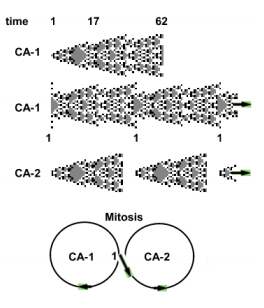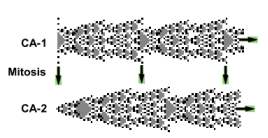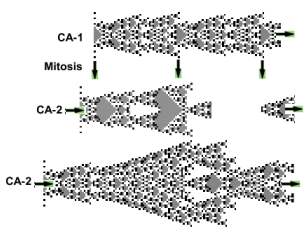 |
Process fission-2
 |
In the following experiment CA-2 is not killed. Whenever CA-1 enters mitosis it plants a stem cell in the existing CA-2. Now mitosis causes CA-2 injury. In this experiment mitosis did not change the CA-2 structure, Some states in the CA-2 cycle are not affected by stem cell planting.
 |
In the next experiment, following CA-2 planting, its state one in the cycle was delayed. Now CA-1 mitosis hits other CA-2 states and changes its structure.
 |
There are four
kinds of outcome after mitosis injures a state:
1. No change, like
in the firts experiment
2. A new
stationary oscillating CA
3. Chaotic
oscillations
4. Death
which is followed by another mitosis
Both
have the same structure (=1), yet their ages differ. Zygote age =
0, and stem cell age > 0. A zygote generates a stem process and later
on, a proliferon, while a stem cell generates a transient
process. As long as the stem process exists, a dead transient process
will be replaced by a new stem cell. Once
stem process is killed, the entire unit disappears.
Stem
cell inherits all stem process properties. Exactly as an objects in object oriented
programming. While in OOP objects maintain their structure. Here objects evolve. In this context, process
oriented programming (POP) may
be regarded as an extension of OOP, a super OOP.
Zygote is represented by the triplet {state = 0; rule =
600, age = 0}. It may be regarded as a gene from which a proliferon evolves.
Yet this blueprint does not specify
proliferon behavior. This example
illustrates the common fallacy of medicine, which claims that gene structure (the human genome) suffices for understanding disease (phenotype).
Further reading:
Proliferon as a JAVA program (streaming tissues)
Setup
restoreparams[1,1,1];
restoreparams[2,1,1]; ++stateno[[no]]; If [nowdat[[no,8]] = 25, stateno[[no]]
= 1]; If[stateno[[1]] == 1,
newzygote[[2]]];